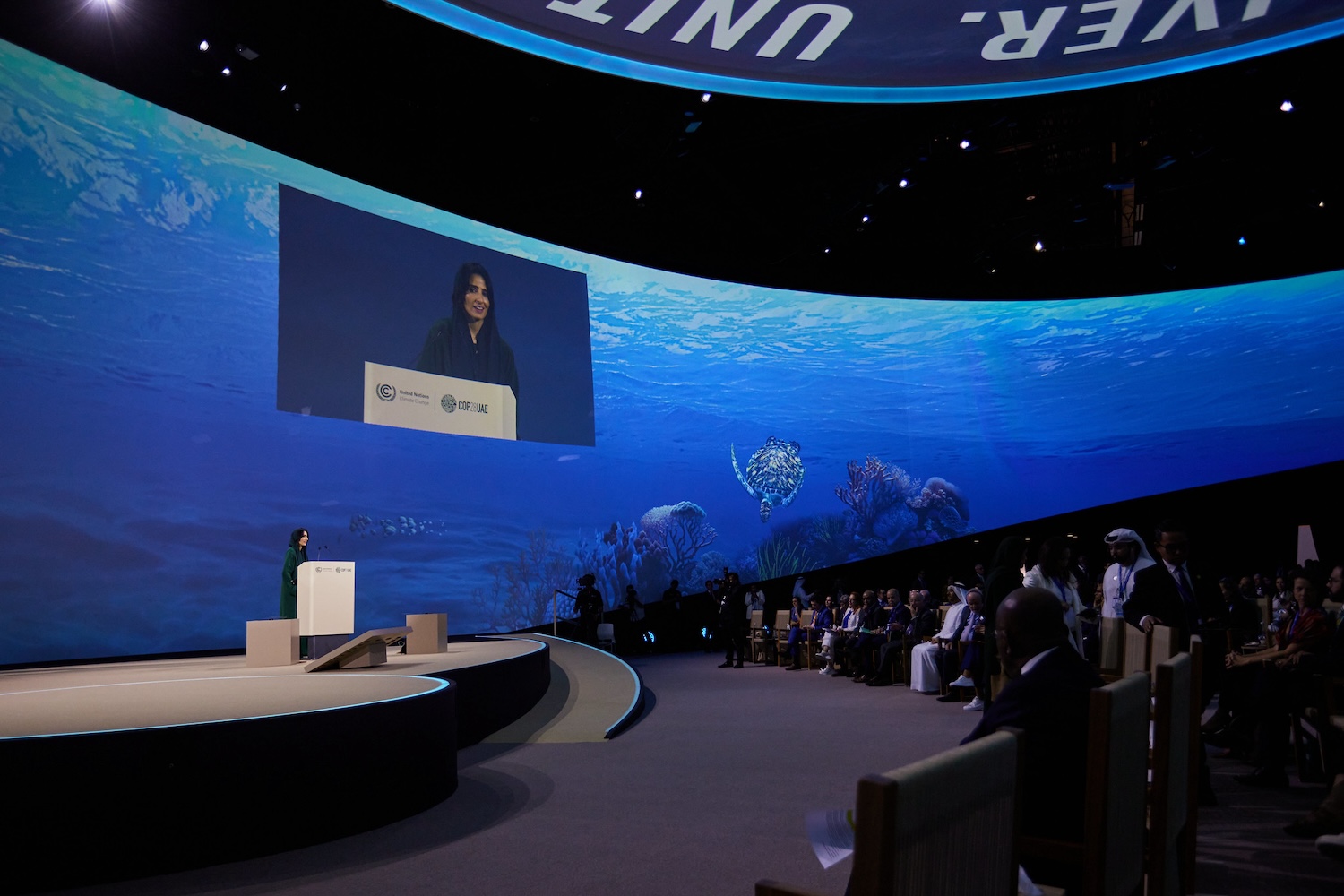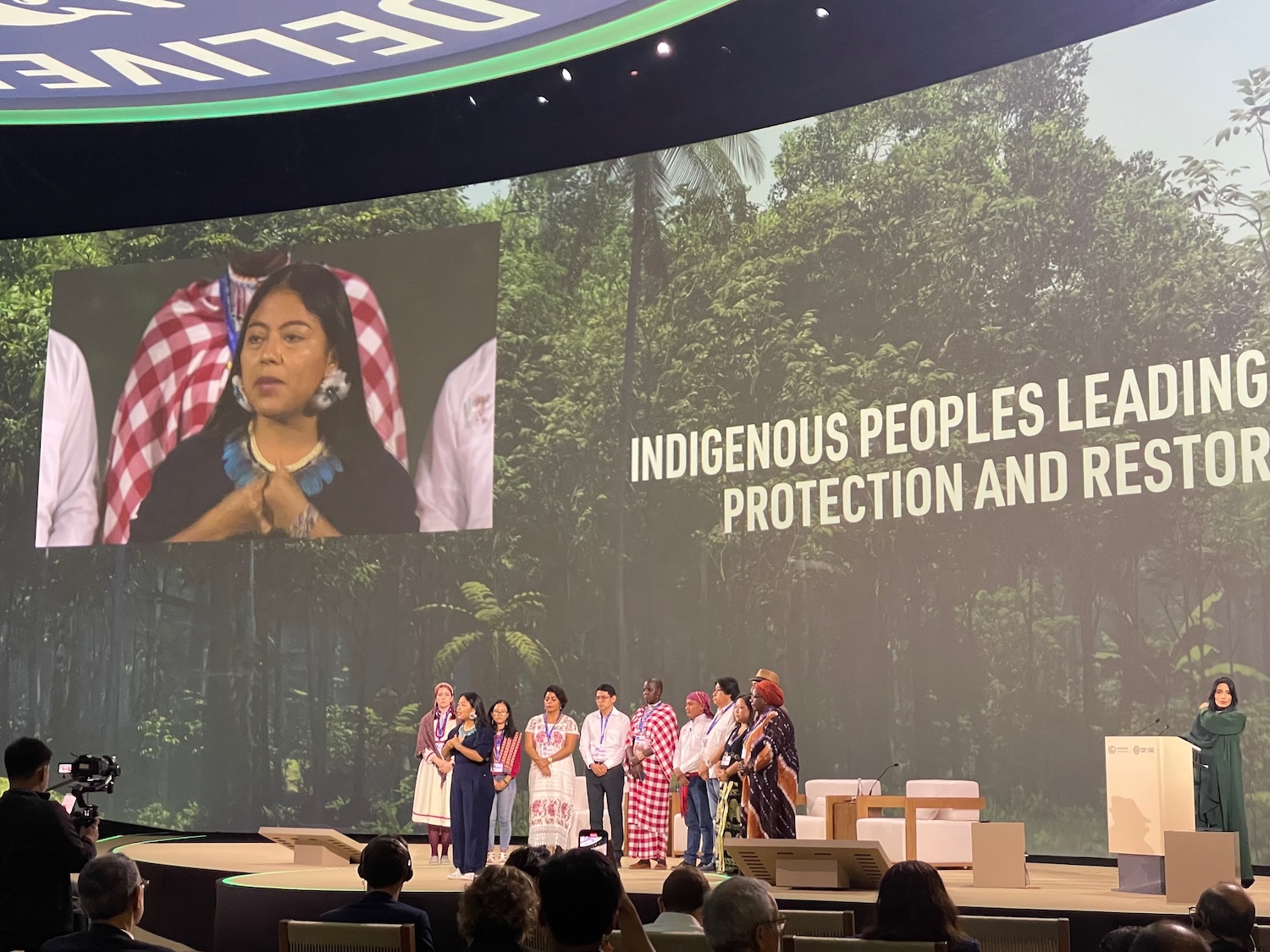
Leaders discuss nature-based solutions at the World Climate Action Summit at COP28. (Image: COP28 UAE/Flickr)
Human activities affect the Earth’s natural means to cope with the climate crisis. We can start solving that now by fostering nature's ability to sequester carbon, experts said at the COP28 climate talks this week.
“We are losing resilience in the whole capacity of the planet to buffer the stress caused by the climate crisis,” Johan Rockström, scientist and director at Potsdam Institute for Climate Change, said at the talks. “We are moving very rapidly toward the 1.5 degree Celsius limit. The only way to avoid it is with an enormous effort by nature.”
Featured in the 2023 Time 100 list, Rockström invented the “planetary boundaries” framework to evaluate systems that regulate Earth as a livable planet. Each system has a designated boundary that we cannot afford to cross if we want to maintain the stability of the planet’s ecosystems.
“We've done scientific studies that show about one-third [of the needed] reduction in greenhouse gases can be driven by nature-based solutions,” said Elizabeth Gray, CEO of the National Audubon Society, one of the world’s oldest nonprofit environmental organizations dedicated to the conservation of birds and their habitats.
Nature-based solutions refer to ways that nature's own processes can be harnessed to mitigate the effects of climate change, whilst supporting biodiversity and enhancing human livelihoods. They include practices such as planting trees, regenerative agriculture, agroforestry and community forest management.
The Rainforest Alliance is another organization heavily advocating for nature-based solutions at COP28 and highlighting its prior work in this area to illustrate nature’s vast potential. For example, Ghana’s Sui River landscape — one of West Africa’s prominent cocoa-growing areas that spans 244,000 hectares and includes five forest reserves — is struggling with deforestation and increased outbreaks of pests and diseases caused by climate change. Rainforest Alliance teamed up with the agri-business Olam and the investment program Partnership for Forests in 2018 to support local communities in setting up legally registered Landscape Management Boards to implement nature-based solutions to these local problems.
“Through these boards in Ghana, 2,600 farmers have been trained in nature-based techniques like water management, soil conservation and shade-tree management, leading to 4,000 farmers adopting the techniques and reporting improved productivity as a result,” Leila Yassine, global advocacy manager at the Rainforest Alliance, said at COP28. “They also initiated the planting of over 200,000 shade- tree seedlings to protect against the adverse effects of climate change.”
Nature’s strength has kept the Earth alive
Our oceans, plants and animals have absorbed 56 percent of man-made carbon dioxide emissions in the past decade, saving us from severe levels of warming, according to the most recent assessment from the Intergovernmental Panel on Climate Change (IPCC). “This is the largest subsidy to the world’s economy,” Rockström said. "If it hadn’t been for this nature’s existence, we would already have passed 1.5 degree Celsius today.”
Nature-based solutions not only reinforce climate resilience by restoring natural habitats and mitigating emissions, but they also aid carbon capture. If adopted on a large scale, they could deliver 37 percent of the climate change mitigation required by 2030 to prevent a dangerous increase in global temperatures and achieve the targeted 1.5 degrees Celsius warming limit of the Paris Agreement. Such nature-based solutions could also save $104 billion in adaptation costs by 2030 and $393 billion by 2050.
Nevertheless, there will be a period between 2030 and 2035 where we will overshoot 1.5 degree Celsius, and the only way to come back would be to decarbonize the global energy system and also to invest in nature, Rockström said.

Restoring and protecting forests and oceans will put us on track
Oceans are the lungs of our planet and also the biggest carbon sink. They generate 50 percent of the oxygen we need, absorb 25 percent of all carbon dioxide emissions and capture 90 percent of the excess heat that is trapped by these emissions. As such, the ocean is central to helping us fight climate change.
After the oceans, forests are the largest storehouses of carbon. They absorb greenhouse gas from the air and store it above and below ground.
A recent global assessment of the carbon capture potential of forests shows that natural forests, outside of urban and agricultural areas, could capture 226 gigatons of carbon if they recovered from degradation and deforestation. That’s equivalent to approximately 23 years of human emissions.
Financing nature-based solutions must be top priority
To achieve those reductions in greenhouse gas emissions, the global community will need to invest $384 billion per year in nature-based solutions by 2025, according to the Rainforest Alliance. Less than half that is invested today.
“There’s an urgent need for increased financial backing for nature-based solutions,” said Yassine of the Rainforest Alliance.
If the world is to meet its climate, biodiversity and land degradation targets, investment in nature-based solutions must at least triple by 2030 and increase fourfold by 2050, advocates say.
Recognizing this need, on Sunday countries, foundations and development banks committed to deliver $1.7 billion in finance to meet climate and biodiversity goals. That includes a $100 million commitment from the United Arab Emirates (UAE), with an initial $30 million investment in the Ghanaian government’s new Resilient Ghana plan that combines development and nature-positive action.
Other partnerships in the initiative will help to develop anti-deforestation plans in the Democratic Republic of the Congo, Papua New Guinea, the Republic of Congo, and Ghana and mobilize private-sector financing for nature-based projects.
“Currently, only 8 percent of the global finance to tackle climate is going to nature-based solutions, yet the solution it is capable of solving over 30 percent of the problem,” said Gray from Audubon. “Financing is a huge issue.”
Funding is a start, but it is not enough. To achieve the full potential of nature to tackle climate change, nature-based solutions must be part of the climate policies drafted by leaders at COP28, leaders said.
“During this COP, nature-based solutions are still not getting the attention they deserve,” said Harisoa Rakotondrazafy, coordinator for the WWF’s Africa Adaptation Hub. “We need to make sure nature-based solutions are valued in addressing climate change impacts. They need to start being a part of the COP agenda because they form a crucial part of global climate adaptation solutions that will bring benefits to communities.”

Indigenous peoples must be given resources to continue protecting the environment
Part of embedding nature into climate policy means listening to the people who interact with — and protect — nature the most. In particular, Indigenous Peoples make up less than 5 percent of the global population but protect more than 80 percent of its biodiversity. As custodians of nature, it is critical to support their seat at the table when discussing climate solutions and to provide them with resources to support their climate actions.
Alongside Rockström, elders from the seven Indigenous socio-cultural regions as defined by the United Nations spoke at the World Climate Action Summit at COP28 to frame the urgency behind restoring the powers of Mother Nature to help combat the climate crisis before us.
“Local communities, Indigenous Peoples, and smallholder farmers play a vital role in climate action, particularly in critical forest ecosystems and agricultural landscapes,” Yassine said. "They understand the realities on the ground and can tailor solutions to their specific local economic, ecological, and social contexts and the unique climate risks they face.”
World leaders including Brazil’s president, Luiz Inácio Lula da Silva, say knowledge from these communities will be a key focus of the COP28-to-COP30 partnership between tee UAE and Brazil. Brazil will host the COP30 climate summit in the Amazonian city of Belém do Pará in 2025.
In a call-to-action for world leaders, Norway’s Prime Minister Jonas Gahr Støre added: “Don’t count on nature to solve the climate crisis but take care of nature and it will solve it.”

Abha Malpani Naismith is a writer and communications professional who works towards helping businesses grow in Dubai. She is a strong believer in the triple bottom line and keen to make a difference. She is also a new mum, trying to work out a balance between thriving at work and being a mum. In her endeavor to do that, she founded the Working Mums Club, a newsletter for mums who want to build better careers and be better mums.














